
|
Taiko |
Shimedaiko |
Atarigane, Canon |
Meaning & Musical Value |
|
Don (Kon) |
Ten |
Chan |
A single loud beat to the center (hara)
of the drum. The left hand on a taiko is sometimes called "kon." This
could be considered the equivalent of a quarter note; but could also be a
half note, etc.. |
|
Do (Ko, Ro) |
Te (Ke, Re) |
Chi (Ki) |
A single firm beat to the hara, but
with a value 1/2 that of "don" (i.e.: twice as fast). The left is sometimes called "ko" or
"ke." This would be an eighth note, if "don" is a quarter note. |
|
DoKo |
TeKe |
ChiKi |
2 Fast beats of equal sound, and power.
This would be the equivalent of 2 eighth notes. |
|
DoRo |
TeRe |
ChiRi |
2 Fast beats, but with a slight
"rolling" feel to the beats. Played "right, left." |
|
Tsu |
Tsu |
Tsu |
A note played softly. The value of the
note is variable. |
|
TsuKu |
TsuKu |
TsuKu |
2 Fast beats played softly (the left
hand is "ku"). |
|
Ka (Ta) |
Ka |
n/a |
A beat played on the edge of the drum
(fuchi), sometimes on the body (ko). The left hand is sometimes notated as "ta." |
|
KaRa |
KaRa* |
n/a |
2 Fast beats played on the fuchi, with
a slight "rolling" feel to the beats. Played "right,
left." |
|
Su |
Su |
Su |
A rest. The value of the rest is
variable, but usually it is one beat of the pulse of the
meter. |
|
Zu |
Zu |
n/a |
Another term for a soft beat, sometimes
played with a slight "drag" to the beat or used for notating a triplet. |